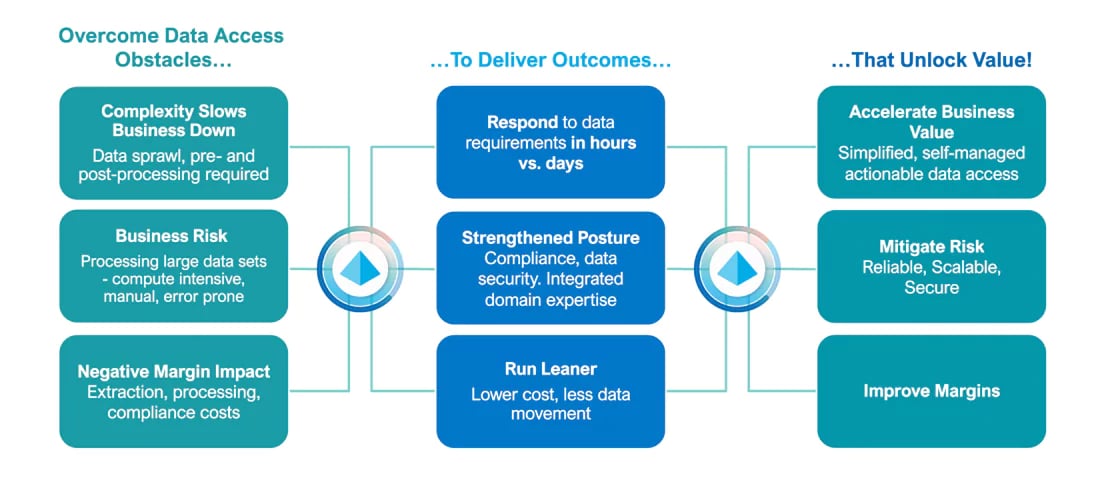BLOG. 5 min read
Avoid Decision Blind Spots With Wealth Management Analytics
December 13, 2023 by Michael Mclaughlin
Change in the wealth management industry is not merely on the horizon; it’s here and happening at an astonishing pace. And while traditional and tailored service models remain valuable, they’re no longer sufficient to serve the demands of a growing and technology-focused population. With the rapid implementation of new technologies, customers want easy and prompt access to data, and they want it now so they can make the best possible investing decisions.
This has made data invaluable for wealth management firms, and those that harness its full potential can adapt, thrive and drive long-term success in this dynamic landscape. But other data challenges also lie ahead for firms who want to maximize their value, which is where wealth management analytics steps in.
What Is the Role of Data in Wealth Management and Analytics?
Data plays a multifaceted role in wealth management, contributing to several aspects, functions and strategies. It serves as the primary source of information for wealth managers, but it also aids in assessing and managing risk, enables the creation of personalized client experiences and provides insights into trends and opportunities. Its role only becomes more important as these trends emerge:
- Financial product commoditization.
- Escrow, proxy, stock plan admin and recordkeeping.
- Transfer agency model going through significant change over the next 5-10 years.
- Millennials’ increasing comfort with technology firms for financial services.
- Buying habits migrate online.
How financial firms gather and use data will set them apart from their competition. Leveraging data to its full potential allows for informed decision-making, the creation of tailored financial products and services, optimized operations and adaptation to changing market factors. According to Deloitte’s research, six core processes in wealth management will be impacted by advanced analytics and big data:
- Business performance management: tracking results and key drivers.
- Client acquisition: creation of comprehensive profiles to generate leads.
- Client retention: leverage channel and social data to assess sentiment and risk in real time.
- Client sales: leverage external data to assess lifetime value, share of wallet, net worth, etc.
- Client advice: tailored portfolio allocations and real-time trade advice/ideas.
- Supervision: compare the amalgamation of data to flag suitability issues, such as client risk tolerance.
All these advancements hold promise for the industry, but how do these aspirations align with the challenges we mentioned earlier?
Many firms are still struggling to simply access their data, let alone maximize it. The most prominent challenge is that data only continues to grow exponentially—and across all directions. As this data grows, its gravitational pull also grows, making it costly and complex to move, and even harder to utilize with all your other resources.
According to Gartner, most organizations still struggle with a comprehensive data management design that allows them to optimally collect, connect and deliver distributed data from heterogeneous data sources and applications for their analytics.
This challenge is only going to get larger and harder to solve. The urgency lies in recognizing that waiting further exacerbates the issue. Taking action today is the best recourse, and it starts with wealth management analytics.
The Importance of Data Analytics in Wealth Management
Wealth management analytics is the use of technology-derived insights from a range of data sources, so wealth managers can optimize portfolios and provide effective services to their clients.
Data analytics, especially through a cloud-based artificial intelligence-powered platform, helps wealth managers connect the dots to unlock value:

Here are some of the benefits of wealth management analytics in more detail:
Accelerate Time to Insight
A robust wealth management data analytics platform helps expedite the process of locating and extracting meaningful information from vast datasets. Wealth managers are able to swiftly identify trends, patterns and opportunities across their operations, and it also shortens the time for wealth managers to understand the market dynamics, client behavior and investment performance.
Improve Decision Making
Data analytics helps consolidate all diverse data sources together. Wealth managers are empowered to make informed, evidence-based decisions to better assess risks, evaluate investment strategies and personalize client interactions. There are no decision blind spots as all the information is collected, legible and correlated.
Enhance Operational Efficiency
Wealth and asset managers no longer need to spend hours or days on data collection and data analysis. Automation, machine learning and AI-powered support streamline operational processes within firms, automating the repetitive collection tasks, optimizing workflows and easily identifying areas for improvement. Manual errors are also mitigated as automation follows strict rules and checking standards, so wealth managers can be assured their data is accurate as well as secure.
Relationship managers spend 60 – 70% of their time on non-advisory activities. One reason is that most still work with legacy IT systems or even spreadsheets.
- McKinsey
Manage Financial Risk
Data analytics tools help wealth managers with comprehensive risk assessment, analyzing vast amounts of historical data and market trends so they can make more calculated investment choices to safeguard clients’ wealth. Firms are also able to address regulatory and profitability demands with easy access to valuable advanced analytics in real-time.
Stay Compliant
A great data analytics platform will ensure that robust data governance is in place so that firms can meet regulatory requirements and maintain data integrity, even when regulations change. Access to data is also governed strictly, so firms know at all times where their data is and who has access to it.
Harness the Power of Data
Ultimately, there’s too much data out there to work retrospectively for wealth management firms. If firms started to build their insights alone today, extracting useful and accurate data would take significant work as it involves understanding, modeling and recreating data layers. There are also the added challenges with data management, permission, security, compliance, etc.
This leaves us with the best option—investing in a data and analytics tool that does it all for you and more.
Stay ahead of your competition and empower better data-driven outcomes with a seamless, end-to-end solution such as SS&C Everywhere. SS&C Everywhere eliminates many of the complexities we’ve discussed, making it easier for wealth firms to gain internal and external data insights quickly. It is a tailored platform for investors and financial services companies to improve margins, mitigate risks and accelerate value through real-time access to diverse information to enable confident decision-making.
Learn more about SS&C Everywhere and how you can avoid decision blind spots.
Written by Michael Mclaughlin
VP Cloud Alliances




.jpg)

